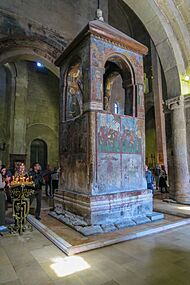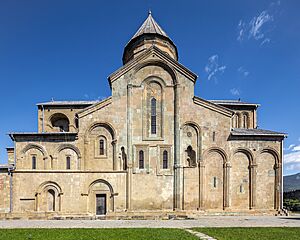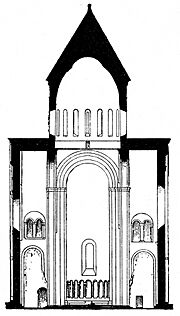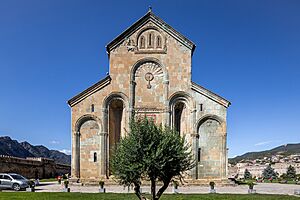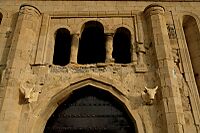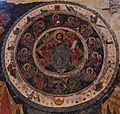Svetitskhoveli Cathedral facts for kids
Quick facts for kids Svetitskhoveli Cathedral |
|
|---|---|
|
სვეტიცხოვლის საკათედრო ტაძარი
|
|
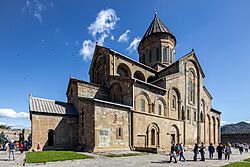
Svetitskhoveli Cathedral's southern façade
|
|
| 41°50′31″N 44°43′16″E / 41.8419°N 44.7211°E | |
| Location | Mtskheta, Mtskheta-Mtianeti |
| Country | Georgia |
| Denomination | Georgian Orthodox Church |
| Architecture | |
| Previous cathedrals | One built in the 4th century AD (by King Mirian III) Second one built in the 5th century AD (during the reign of Vakhtang I) |
| Architect(s) | Arsukisdze |
| Architectural type | Cathedral |
| Style | Cross-in-square |
| Groundbreaking | 1010 |
| Completed | 1029 (during the reign of King George I) |
| Specifications | |
| Length | 57.7 metres (189 ft) |
| Width | 27 metres (89 ft) |
| Height | 49 metres (161 ft) |
| Number of domes | 1 |
| Materials | stone |
The Svetitskhoveli Cathedral (Georgian: სვეტიცხოვლის საკათედრო ტაძარი, svet'icxovlis sak'atedro t'adzari), which means the Cathedral of the Living Pillar, is a very old Christian church. It is located in the historic town of Mtskheta, Georgia. This town is northwest of Georgia's capital city, Tbilisi.
Svetitskhoveli is a stunning example of architecture from the early and high Middle Ages. It is so important that UNESCO has named it a World Heritage Site. Today, it is the second largest church building in Georgia. Only the Holy Trinity Cathedral is bigger.
People believe that the mantle (robe) of Christ is buried here. Because of this, Svetitskhoveli has been one of the most important Georgian Orthodox churches for a very long time. It is a highly respected place of worship in the region. For centuries, Georgian kings were buried inside this cathedral.
The church you see today was finished between 1010 and 1029. It was built by a famous Georgian architect named Arsukisdze. However, the site itself has been a church location since the early 300s AD. The outside of the cathedral shows beautiful decorations typical of the 11th century.
Svetitskhoveli is a cultural landmark that needs protection. It has faced many challenges over time. Sadly, many of its precious wall paintings (frescoes) were lost. This happened when Russian authorities painted over them. Still, it remains one of the four Great Cathedrals of the Georgian Orthodox world.
Contents
History of Svetitskhoveli Cathedral
How the First Church Was Built

The very first church on this spot was built in the 300s AD. This was during the time of King Mirian III of Kartli (also known as Iberia). Saint Nino is said to have chosen this special place. It's where the Mtkvari (Kura) and Aragvi rivers meet.
According to old Georgian stories, a Jewish man named Elias from Mtskheta was in Jerusalem. This was when Jesus was crucified. Elias bought Jesus’ robe from a Roman soldier. He then brought it back to Georgia. When he returned home, his sister Sidonia met him. As soon as she touched the Robe, she died from the strong emotions. The Robe could not be taken from her hands. So, she was buried with it. The place where Sidonia and the Robe are buried is still inside the cathedral.
Later, a huge cedar tree grew from her grave. Saint Nino ordered the tree to be cut down to build a church. Seven pillars were made from this tree for the church's foundation. But the seventh pillar had special powers. It floated up into the air by itself! It only came back down after Saint Nino prayed all night. People also said that a sacred liquid flowed from this seventh pillar. This liquid could cure all kinds of diseases.
In Georgian, sveti means "pillar" and tskhoveli means "life-giving" or "living." This is how the cathedral got its name. You can see a painting (icon) of this event on the third pillar inside the church, to the left of the entrance. This painting is very common in Georgia. It shows Sidonia's body at the base of the cedar tree stump. An angel is lifting the pillar towards heaven. Saint Nino is in the front. King Mirian and Queen Nana are on the right and left sides. Georgia officially became a Christian country in 337 AD.
Changes Over Time
The Svetitskhoveli Cathedral has been damaged many times throughout history. It was attacked by Arabs, Persians, and Timurids. Later, it was also damaged during Russian rule and the Soviet period. Earthquakes have also caused damage to the building.
The cathedral you see today was built between 1010 and 1029. The architect was Arsukidze. He was invited by the Catholicos Melchizedek I of Georgia. The king of Georgia at that time was Giorgi I.
A big repair happened at the end of the 1300s after Tamerlane destroyed parts of it. Another major renovation took place in the early 1400s. That's when the current dome was built. It was then repaired again in the mid-1600s.
During a restoration project in 1970-71, led by Vakhtang Tsintsadze, something important was found. They discovered the base of an older church, a basilica. This basilica was built in the late 400s by King Vakhtang Gorgasali. It was built after Saint Nino's original church. In early Georgian church building, the basilica was the main style. This was before the crossed-dome style became popular.
The cathedral is surrounded by a strong defensive wall. This wall was built from stone and brick in 1787. It was built during the reign of King Erekle II (Heraclius).
In the early 1830s, the Russian Emperor visited the cathedral. Because of this, the old galleries around the church were torn down. They were in bad condition and the authorities wanted the church to look "tidier." However, the Czar never actually came to visit.
In 1963, archaeologists found the remains of the Patriarch's house from the 11th century. This was on the southern part of the wall. Inside the churchyard, they also found parts of the two-story palace of Patriarch Anton II.
Cathedral Architecture
The cathedral stands on flat land in the middle of the old town of Mtskheta. It is the most important building there and can be seen from almost everywhere.
During the 1970–71 restoration, archaeologists found the base of a three-story basilica. This basilica was likely built by Vakhtang Gorgasali after St. Nino's first church. You can still see parts of it in the western and southeastern areas, and under the floor. Even older wooden church remains were found inside the southern part of the cross-shaped building.
The design of the current Svetitskhoveli Cathedral, built around 1020, uses the cross-dome style. This style became popular in Georgia after the country was united by Bagrat III (978-1014). In this style, the dome is placed over the center of the church, connecting all four sides. The church originally had a more balanced, three-step shape. It had entrances (portals) from the south, west, and north. The northern and southern entrances were removed in the 1830s. Today, you enter the cathedral from the west.
The church's design helps with good sound (acoustics). Large windows in the dome and walls let in a lot of light. The church's shape is like a cross, with shorter side arms and longer front-to-back arms. The east end has a rounded section called an apse. The dome of Svetitskhoveli has been rebuilt several times over the centuries to keep the church strong. The current dome is from the 1400s. Its top part was rebuilt in the 1600s, making it a bit smaller than before.
The main stone used for the cathedral is a sandy yellow color. Red stone is used around the apse window for decoration. The green stone in the dome's base is from the 1600s.
The outside walls of the church are richly decorated. The curved, blind arches (arches that are part of the wall, not openings) are still original from the 11th century. These arches seem to move up and down with the height of the wall, creating a feeling of constant motion. Two deep niches (recessed areas) on the eastern wall stand out against the bright walls around them. Each window is surrounded by decorative patterns and designs that look like peacock tails. Similar decorations are found higher up on the eastern niches. A message above the eastern windows says that the church was built by Catholicos Melchisedek. Above this, two low-reliefs (sculptures that stick out slightly from the wall) show an eagle with open wings and a lion below it. These are to the south of three newer windows under the roof.
A large window fills most of the top western side of the church. Its decoration shows the Ascension of Jesus. Christ is sitting on a throne with two angels on either side. This triangle-shaped decoration fits well with the triangle of the roof edge (cornice) and an arch below it. The original sculpture on this wall is gone, but it has been restored many times, most recently in the 1800s.
The Architect Arsukidze
There is a famous story about a sculpture on the outside northern wall. It shows a right arm and hand holding an L-square, which is a tool for stonemasons. An inscription next to it says:
The Hand of Arsukidze,
slave of God, may forgiveness be his.
Another inscription on the east wall also suggests that Arsukidze did not live to see his masterpiece finished in 1029:
This holy church was built by the hand of Thy wretched servant, Arsukidze.
May your soul rest in peace, O Master.
The novel The Hand of the Great Master by Konstantine Gamsakhurdia tells a legend about Arsukidze. The story says that a priest, who was also Arsukidze's teacher, became very jealous of his success. He used his power with the king to have the architect's right hand cut off. The novel also suggests that King George was jealous of Arsukidze because of his love for a beautiful woman named Shorena. However, there is no historical proof for this legend.
Art Inside: Icons and Frescoes
The inside walls of the cathedral were once completely covered with beautiful medieval wall paintings (frescoes). But many of them have not survived. In the 1830s, Emperor Nicholas I was planning to visit Mtskheta. Russian authorities removed the galleries and painted over many old frescoes. They wanted the cathedral to look "tidier" for the Emperor. In the end, the Czar never even came. Today, after much careful restoration, some frescoes remain. These include a 13th-century painting of the "Beast of the Apocalypse" and figures of the Zodiac.
The walls are also decorated with many Christian Orthodox icons. Most of these are not the original ones. The original icons are kept in the national museums of Georgia. The stone carvings in the church also feature grapes. This shows Georgia's long history of making wine. The large painting of Jesus at the altar was done by a Russian artist in the 1800s. Most of the icons you see here today are from the 1900s. Some are copies of older icons and frescoes from other churches in Georgia.
Two bulls' heads on the eastern wall are from the 400s church. They show how folk art influenced Christian art in those early times.
Baptismal Font
To the right of the cathedral's entrance, there is a stone baptismal font. It dates back to the 300s. People believe it was used to baptize King Mirian and Queen Nana. Right behind the font, you can see a copy of the sculpture of Arsukidze's right hand and tool, which is also on the north wall outside.
Copy of the Chapel of Holy Sepulchre
On the south side of the cathedral, there is a small stone church built right into the main building. This is a symbolic copy of the Chapel of Holy Sepulchre in Jerusalem. It was built between the late 1200s and early 1300s. It was placed here to show that Svetitskhoveli is the second most sacred place in the world. This is because of Christ's robe being buried here.
In front of this stone chapel, the westernmost structure between the aisle and the main part of the church marks Sidonia's grave. Parts of the original life-giving pillar are also here. This section was built in the 1600s. Paintings showing the lives of King Mirian and Queen Nana are here. There are also portraits of the first Christian Byzantine Emperor, Constantine I, and his mother Helena. These were painted by G. Gulzhavarashvili at that time. Traces of the 4th-century church's foundations have been found in this area.
Throne of the Catholicos-Patriarch
The second structure in line with the columns of the southern aisle was also built in the 1600s. It was made as the throne for Catholicos Diasamidze. It is no longer used for this purpose. Today, the Georgian patriarch's throne is usually in the center of the church.
Burials of Kings and Queens
-
Tomb of Vakhtang Gorgasali in Svetitskhoveli Cathedral.
Svetitskhoveli was not only where Georgian kings were crowned. It was also their burial place. We know that ten kings were buried here. However, only six tombs have been found, all located in front of the altar.
- The tomb of King Vakhtang Gorgasali is in the central part of the cathedral. You can spot it by the small candle fortress in front of it.
- King Erekle II's tomb is easy to find because it has a sword and shield on it.
- His son, George XII, was the last king of Georgia. His marble tomb is next to his father's.
- Also in front of the altar are the tombs of David VI, George VIII, and Luarsab I.
- Various members of the Bagrationi royal family are also buried here. This includes Tamar, the first wife of George XI. Her tombstone from 1684 has writing in both Georgian (Asomtavruli) and Arabic script.
Other Burials
- Domentius IV of Georgia
Other Buildings Around the Cathedral
The cathedral stands in the middle of a large yard. This yard is surrounded by tall walls with towers, built in the 1700s. The top part of the wall was designed for military use and has places for guns. The main entrance to the cathedral area from the wall is on the west side.
The wall has eight towers: six are round and two are square. In the southwestern part of the yard, you can find the remains of a palace. There is also an 11th-century two-story tower above the gate. This tower is covered with stones and has arches. It also has two bull heads on its west side. The ground floor has a vaulted passage. A message tells us that this tower was built by Catholicos Melchisedek.
Threats to the Cathedral
A report from UNESCO in 2010 found that there are problems with the cathedral's structure. These issues could threaten the overall stability of the building.
Images for kids


